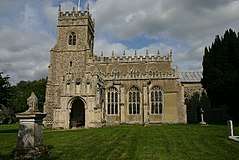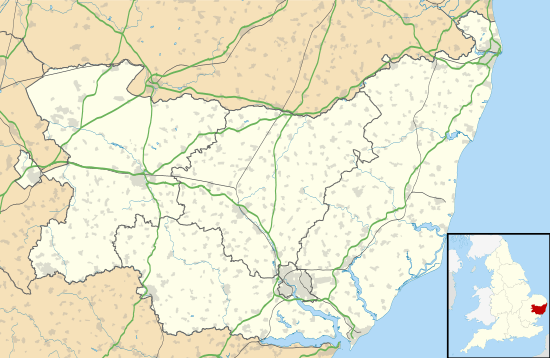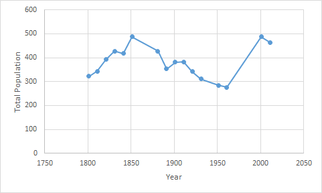Hessett
Hessett is a village and civil parish in the Mid Suffolk district of Suffolk in eastern England. Hessett is located around four miles south east of Bury St Edmunds along Manor Road[2] with only a few smaller roads within the area. In 2005 its population was 490 which has been the highest recorded population since its peak in 1850.[1] Hessett is south of Beyton and west of Drinkstone which are both larger towns with more accessible routes.
| Hessett | |
|---|---|
 Church of St Ethelbert | |
 Hessett Location within Suffolk | |
| Population | 490 [1] |
| District | |
| Shire county | |
| Region | |
| Country | England |
| Sovereign state | United Kingdom |
| Post town | Bury St Edmunds |
| Postcode district | IP30 |
| Police | Suffolk |
| Fire | Suffolk |
| Ambulance | East of England |
| UK Parliament | |

In the 1870s, John Marius Wilson's (Imperial Gazetteer of England and Wales) described Hessett like this:
HESSETT, a parish in Stow district, Suffolk; 2½ miles S of Thurston r. station. The church was built by the Bacons; is in good condition; has a beautiful window and a tower; and contains tombs of the Bacons.[3]
History
The small village has been present in this area for over "1000 years with the earliest mention in AD 1005 when Ulfketel gave the village (alongside others) to Abbey Bury, St. Edmund's."[4] According to the 2011 Census there were 216 males and 248 females living in Hessett at this time[5] which is a much smaller population to the current estimations of Hessett's population which is 490 according to the last census taken out.
Hessett can be originally referred to "Hedge Fold" [6] then breaking down Hessett's elements into hecg meaning "Hedge" and Set referring to "a dwelling, a camp, a place for animals, a stable, a fold" [7] This can be interpreted as the parish being named and recognised by its arable land and key occupations in agriculture.
Church
The Church in Hessett represents the majority of the village due to its features as "the interior of the church contains some stained windows, and a small chapel in the N. aisle containing a monument to Colonel Aldrich"[8] which represents features of Christianity. The Church also provides the history of Hessett as it "contains tombs of the Bacons, who built the church".[9] According to the work taken out by Simon Knott, his research over the past 10 years has contributed hugely to the history of the Church of St. Ethelbert whereby he acknowledges the "typical Suffolk perpendicular church of the 15th century"[10] along with a mention of the particular features found in the Church of St. Ethelbert including "the chancel is separated from the nave by the 15th century rood screen, which is elegantly painted and gilt on the west side".[11] There was a period in 1969 whereby Mrs. Mary Moss claimed Reverend Kenneth Matthews (Reverend of the Hessett's Church at this time) managed to cure her condition of being unable to walk when the Reverend "put his hands on her head and told her to get up from the wheelchair"[12] which led to large numbers of people traveling to the Church in order to receive the same magical treatment for their conditions.
Industry

The census in 1831 gave a more detailed structure into people's occupation in comparison to the 1801 census, for Hessett, the majority of the male population aged 20 and over were involved in some agricultural occupation as "the land is chiefly arable",[13] for example; " Farmers employing labourers and agricultural labourers." [14] The remaining of males in Hessett held occupations of "Retail and Handicrafts and 2 Farmers not employing Labourers".[15] This information shows that the majority of males living in Hessett in 1831 were mostly involved in agricultural occupations rather than Capitalists professions. According to Vision of Britain, the main occupation which dominated Hessett in 1831 would be servants and labourers with "63"[16] people being grouped in this occupation. There is a clear change in the type of occupations into the next record of data in 1881 where the type of occupations were more detailed, for example, from the table of Occupations of male and females in Hessett in 1881 produced from Neighbourhood Statistics and Vision of Britain it gives a broader view of who and what the occupations were formed of. From the table we can see that the majority of females were grouped into having an unknown occupation which would indicate that they did housework and looked after families and for males the main occupation was "conveyance of men, goods and messages" with 80 men holding this occupation. There is an obvious shift in the 'type' of occupations held for example the occupations for the 1831 record were sorted into 4 categories where as the later data was sorted into 6 categories and instead of being "labourers and servants" for the 1831 dataset the labouring and agriculture occupations were grouped as being; vegetable substances, food and lodging, animals and conveyance of men, goods and messages which could be related to the later record of data in 1881 being more specified than that of 1831 but most of the occupations still relate to some sort of agricultural profession. With the data from both the 1831 and 1881 occupational data there is a large indication that there wasn't much opportunity for a range of occupations other than that was based around agriculture.
Demographics

From the population time series created using data from Neighbourhood Statistics and Vision of Britain, the graph shows some considerable changes in the population for Hessett. From 1801 when the first census record was carried out there was evidence of a general increase in the population (apart from the slight fluctuation in approximately 1827 to 1835) until 1850. There is a decline in the population from 1850 to approximately the 1970s, where this decline could be said to coincide with key points in England's history, for example, WW1 which wiped out a large proportion of the men in England. As according to figures produced in the 1920s by the Central Statistical Office, the "total British Army casualties were 956,703".[17] For Hessett in 1911 there was 382 people living in Hessett but by 1921 there were 40 fewer people living in this small village.[18] The population time series also shows the establishment of the NHS in the 1950s [19] which could contribute to the rise of population in England at this time as more healthcare was becoming available. Furthermore, after the 1945 map of Hessett retrieved from Vision of Britain, it shows the extent of the area of Hessett. It is a very small village with the heart of the village being The Green which is a small area of grass. The boundary of the 1945 map includes the Monk Wood and some part of the Drinkstone Park but not all.
From the most recent statistics produced by the 2011 census report it showed one of the highest populations that Hessett has held other than in 1850 and 2000 with a total population in Hesset of 464 residents with 216 being male and 248 female showing a dominating female population in this area.[20]
Housing
From the data of properties sold from 2015 the average housing pricing is relatively high as the average price for a detached house in Hessett in £314,681 with 8 properties being sold in the IP30 postcode (June 2015).[21] Overall, there has been no significant change in the number of people living in Hessett from 1831 to 1861 apart from 1831 to 1841 where the housing occupancy increased from 45 people to 89 people [22] however, the data shows only one house being under construction for 1831 which means there is a possibility that the Parish grew in the 10 years from the 1831 Census to the 1841 Census.
References
| Wikimedia Commons has media related to Hessett. |
- Estimates of Total Population of Areas in Suffolk Archived 19 December 2008 at the Wayback Machine Suffolk County Council
- "Map of Hessett". Mappy. Retrieved 23 April 2017.
- Wilson, John Msrius (1870–72). Imperial Gazetteer of England and Wales. Edinburgh: A. Fullerton & Co.
- "Hessett Parish Council". Hessett Parish Council. Retrieved 28 February 2017.
- Neighbourhood Statistics, Office for National Statistics. "Hessett: Key Figures for 2011 Census: Key Statistics". Neighbourhood Statistics. Office for National Statistics. Retrieved 2 February 2017.
- "Key to English Place Names- Hessett". Key to English Place Names. Retrieved 15 March 2017.
- "Key to English Place Names- Hessett". Key to English Place Names. Retrieved 15 March 2017.
- "Genuki". Genuki, Hessett Suffolk. Retrieved 21 March 2017.
- "Genuki". Genuki, Hessett Suffolk. Retrieved 21 March 2017.
- Knott, Simon. "St. Ethelbert, Hessett". Suffolk Churches. Retrieved 7 March 2017.
- Knott, Simon. "St. Ethelbert Hessett". Suffolk Churches. Retrieved 7 March 2017.
- "History of Hessett". Hessett Parish Council. Retrieved 7 March 2017.
- "Genuki". Genuki, Hessett Suffolk. Retrieved 21 March 2017.
- "Hessett's 1831 Occupational categories". A Vision of Britain. Retrieved 21 March 2017.
- "Hessett's Ocupational categories: Males ages 20 and over split into 9 categories". A Vision of Britain. Retrieved 21 March 2017.
- "Social structure for Hessett in 1831". A Vision of Britain through time. Retrieved 23 April 2017.
- "Some British Army Statistics of the Great War". The Long, long trail. Central Statistical Office. Retrieved 23 April 2017.
- "Total population of Hessett". Vision of Britain. Retrieved 12 April 2017.
- "The History of the NHS". NHS. Retrieved 12 April 2017.
- "Key Figures for 2011 Census: Key Statistics Hessett". Neighborhood Statistics. Office for National Statistics. Retrieved 7 March 2017.
- "Avergage house prices (June 2015)" (PDF). Midsuffolk. Archived from the original (PDF) on 13 March 2017. Retrieved 12 March 2017.
- "Housing Occupancy in Hessett". A Vision of Britain. Retrieved 21 March 2017.